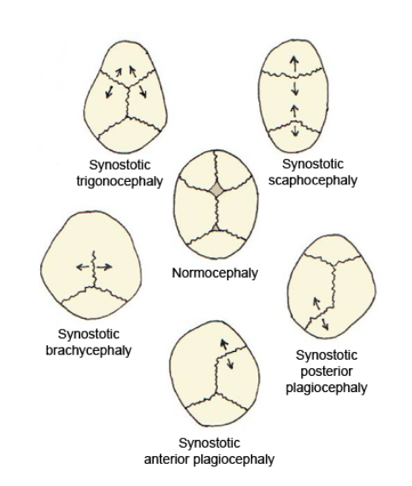Craniosynostosis 5, Susceptibility To

A number sign (#) is used with this entry because of evidence that susceptibility to craniosynostosis-5 (CRS5) is caused by variation in the ALX4 gene (605420) on chromosome 11p11.
DescriptionPremature fusion of the various sutures in the human neurocranium (skull vault and base) is defined as craniosynostosis (CRS). Clinical consequences include abnormal head shape and increased intracranial pressure, which may result in neurologic symptoms, developmental delay, and hearing or vision problems. Approximately 80% of cases are classified as nonsyndromic craniosynostosis and present as isolated suture fusion with no other associated anomalies. Sagittal suture fusion is the most common form of isolated craniosynostosis, accounting for 40 to 58% of all isolated cases (summary by Yagnik et al., 2012).
For a discussion of genetic heterogeneity of craniosynostosis, see CRS1 (123100).
Molecular GeneticsYagnik et al. (2012) studied 203 patients with isolated craniosynostosis, of whom 197 had single sagittal suture fusion and 6 had multiple-suture fusion with sagittal involvement. In 111 of the 203 probands with single-suture fusion and all 6 probands with multiple-suture fusion, Boyadjiev (2007) had previously excluded mutations in hotspot areas of the FGFR1 (136350), FGFR2 (176943), and FGFR3 (134934) genes, and the entire TWIST1 gene (601622). Yagnik et al. (2012) sequenced the entire coding region of the candidate gene ALX4 (605420) in the 203 CRS probands and identified 2 missense variants: V7F (605420.0009) in a patient with single-suture sagittal craniosynostosis, and K211E (605420.0010) in a patient with metopic, right squamous, and sagittal suture fusion. Postsurgical evaluation of both probands confirmed age-appropriate development and the absence of associated anomalies. Functional analysis showed gain-of-function for both variants, which were also present in an unaffected parent from each family. Yagnik et al. (2012) concluded that the variants represent low-penetrance mutations that predispose to CRS but are not causative by themselves.